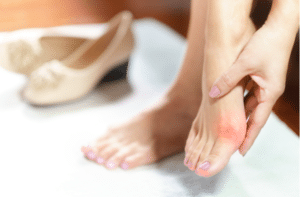 There is no other body part that is as overworked and underappreciated as our feet. They carry the force of our entire bodies, including whatever items we’re carrying, and they do so without failing us most of the time. It can be easy to overlook this important limb, but developing foot conditions, like bunions, is a serious matter that becomes very hard to ignore over time.
There is no other body part that is as overworked and underappreciated as our feet. They carry the force of our entire bodies, including whatever items we’re carrying, and they do so without failing us most of the time. It can be easy to overlook this important limb, but developing foot conditions, like bunions, is a serious matter that becomes very hard to ignore over time.
Don’t let your foot health get to that point– learn how to tell if you have a bunion during the early stages so you can avoid painful situations and live your life with sturdy, reliable feet. We’ll discuss what the first signs of a bunion are so you can become alert before a serious condition develops.
Don’t Ignore the Little Things
Bunions can start off looking innocuous, like small blisters or bumps on the side of the foot. One of the main differences between those and the start of this foot condition lies in a couple of tell-tale symptoms. If your bump feels boney and develops on the side of your foot, it could be a bunion. Additionally, if your big toe starts pressing inward and pushing on your other toes, that can also be a sign that you are growing a bunion.
Irritated skin around a small bump can also be an early symptom of this health condition, as well as redness and swelling around the big toe joint, and callouses along the edges of your big toe or edge of your foot.
Don’t ignore little growths, bumps, or changes in your foot area. Small problems can turn into big ones if left untreated for too long.
Runs in the Family
Bunions aren’t hereditary, but we do tend to inherit the same kinds of feet as our family members, and therefore some people are more susceptible to this health condition than others. People who have low arches or flat feet are more prone to developing foot problems, like bunions, and unfortunately, they are born with foot structures like these– they don’t develop over time.
If you have loose joints, you are more likely to develop bunions as well. If your feet fall into any of the categories above, there are a few things you can do to prevent bunions from happening.
Preventative Measures
Many bunions develop when feet are squeezed into narrow footwear, like heels or tight sneakers. Make sure you are wearing the right kinds of shoes that allow for foot flexibility and have plenty of room for your toes to breathe. They should be supportive as well, and it’s best to avoid any type of high heels.
Some good shoe options are supportive sandals, gym shoes, and shoes made from soft leather. If you think you’re starting to develop a bunion, the best way to find out is by making an appointment with our doctors at the Foot & Ankle Clinics of Utah. We have locations in Payson, Springville, and American Fork, UT, and you can schedule a consultation today by filling out our contact form here.

